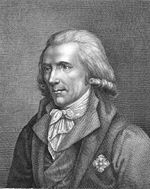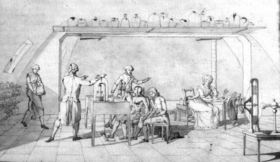Indice
Utente:Grignoste/Sandbox
Traduzione in corso, non modificate per favore

Marie-Anne Pierrette Paulze (20 gennaio 1758 a Montbrison, Loire, Francia – 10 febbraio 1836) fu una nobile e chimica francese.[1] Madame Lavoisier fu la moglie del nobile e scienziato Antoine Lavoisier, lavorò come sua compagna di laboratorio contribuendo al suo lavoro scientifico.[1] Svolse un ruolo chiava nella traduzione di svariati lavori scientifici, e fu fondamentale per la standardizzazione del metodo scientifico.
Biografia
[modifica | modifica wikitesto]Il padre fu avvocato parlamentare e finanziatore. la maggior parte delle sua entrate derivano dalla Ferme Générale, Un consorzio privato che pagava la monarchia francese per il diritto di riscuotere alcune tasse. La madre, Claudine Thoynet Paulze, morì nel 1761, lasciando Marie-anne a solo 3 anni con le sue sorelle. Dopo la morte della madre Marie-Anne fu lasciata in convento dove ricevette la sua educazione.
all'età di 13 anni ricevette la proposta di matrimonio dal cinquantenne Conte d'amerval.[2] Il padre provò ad opporsi all'unione, ma ricevette la minaccia di essere espulso dalle Ferme Générale. Per cercare di contrastare indirettamente il matrimonio, il padre Jacques Paulze fece un'offerta a uno dei suoi colleghi per chiedere la mano di sua figlia. Antoine Lavoisier, un nobile e scienziato francese, accettò la proposta. I due si sposarono il 16 dicembre 1771. Lavoisier aveva circa 28 anni, mentre Marie-Anne aveva circa 13 anni.
Lavoisier continuò a lavorare alla Ferme-Générale fino al 1775 quando fu nominato amministratore delle polveri da sparo, il che costrinse la coppia a spostare la propria residenza all'arsenale di Parigi.[1] Qui l'interesse di Lavoisier per la chimica, formatosi nel laboratorio chimico di Guillaume François Rouelle, e con la sicurezza finanziaria garantita dalla sua famiglia, dalla moglie e da vari titoli e investimenti riusci a costruire un laboratorio chimico all'avanguardia. Marie-Anne si interessò presto al suo lavoro scientifico e partecipò attivamente alla lavoro di ricerca.
Con il crescere del suo interesse ricevette l'istruzione da Jean Baptiste Michel Bucquet e Philippe Gingembre, a quel tempo, entrambi colleghi di Lavoisier.
I Lavoisier Passavano la maggior parte del loro tempo in laboratorio lavorando insieme e conducendo esperimenti su diversi fronti. Marie-Anne fu di grande aiuto anche nella traduzione dall'inglese al francese degli articoli scientifici. In effetti, la maggior parte degli sforzi di ricerca svolti in laboratorio era in realtà uno sforzo congiunto tra Marie-Anne e suo marito, con Paulze che svolgeva principalmente il ruolo di assistente di laboratorio.
La rivoluzione francese
[modifica | modifica wikitesto]In 1794 Lavoisier, due to his prominent position in the Ferme-Générale, was branded a traitor during the Reign of Terror by French revolutionaries. Paulze's father, another prominent Ferme-Générale member, was arrested on similar grounds. On 28 November 1793 Lavoisier surrendered to revolutionaries and was imprisoned at Port-Libre. Throughout his imprisonment Paulze visited Lavoisier regularly and fought for his release. She presented his case before Antoine Dupin, who were Lavoisier's accuser and a former member of the Ferme-Générale. She told of her husband's accomplishments as a scientist and his importance to the nation of France. Despite her efforts, Lavoisier was tried, convicted of treason and executed on 8 May 1794 in Paris, at the age of 50. Jacques Paulze was also executed on the same day.[1]
After his death, Paulze became bitter about what had happened to her husband. She was thrown into bankruptcy following the new government's confiscation of her money and property (which were eventually returned). In addition, the new government seized all of Lavoisier's notebooks and laboratory equipment. Despite these obstacles, Marie-Anne organized the publication of Lavoisier's final memoirs, Mémoires de Chimie, a compilation of his papers and those of his colleagues demonstrating the principles of the new chemistry. The first volume contained work on heat and the formation of liquids, while the second dealt with the ideas of combustion, air, calcination of metals, the action of acids, and the composition of water. In the original copy, Paulze wrote the preface and attacked revolutionaries and Lavoisier's contemporaries, whom she believed to be responsible for his death. This preface, however, was not included in the final publication. Nevertheless, her efforts secured her husband's legacy in the field of chemistry.[senza fonte]
Later life
[modifica | modifica wikitesto]
Paulze eventually remarried in 1804, following a four-year courtship and engagement to Benjamin Thompson (Count Rumford). Rumford was one of the most well-known physicists at the time, but the marriage between the two was difficult and short-lived.[3] Paulze also insisted throughout her life that she retain her first husband's last name, demonstrating her undying devotion to him. Marie died very suddenly in her home in Paris on 10 February 1836, at the age of 78.[1] She is buried in the cemetery of Pere-Lachaise in Paris.
Contributions to chemistry
[modifica | modifica wikitesto]
Paulze accompanied Lavoisier in his lab during the day, making entries into his lab notebooks and sketching diagrams of his experimental designs. The training she had received from the painter Jacques-Louis David allowed her to accurately and precisely draw experimental apparatuses, which ultimately helped many of Lavoisier's contemporaries to understand his methods and results.[3] Furthermore, she served as the editor of his reports. Together, the Lavoisiers rebuilt the field of chemistry, which had its roots in alchemy and at the time was a convoluted science dominated by George Stahl’s theory of phlogiston.
In the eighteenth century the idea of phlogiston (a fire-like element which is gained or released during a material's combustion) was used to describe the apparent property changes that substances exhibited when burned. Paulze, being a master in the English, Latin and French language, was able to translate various works about phlogiston into French for her husband to read. Perhaps her most important translation was that of Richard Kirwan's 'Essay on Phlogiston and the Constitution of Acids', which she both translated and critiqued, adding footnotes as she went along and pointing out errors in the chemistry made throughout the paper.[3] Despite her contributions, she was not attributed as a translator in the original work but in later editions.[4] She also translated works by Joseph Priestley, Henry Cavendish, and others for Lavoisier's personal use. This was an invaluable service to Lavoisier, who relied on Paulze's translation of foreign works to keep abreast of current developments in chemistry. In the case of phlogiston, it was Paulze's translation that convinced him the idea was incorrect, ultimately leading to his studies of combustion and his discovery of oxygen gas.
Paulze was also instrumental in the 1789 publication of Lavoisier's Elementary Treatise on Chemistry, which presented a unified view of chemistry as a field. This work proved pivotal in the progression of chemistry, as it presented the idea of conservation of mass as well as a list of elements and a new system for chemical nomenclature. Paulze contributed thirteen drawings that showed all the laboratory instrumentation and equipment used by the Lavoisiers in their experiments. She also kept strict records of the procedures followed, lending validity to the findings Lavoisier published.
Before her death, Paulze was able to recover nearly all of Lavoisier's notebooks and chemical apparatuses, most of which survive in a collection at Cornell University, the largest of its kind outside of Europe.[5] The year she died, a book was published, showing that Marie-Anne had a rich theological library with books which included versions of The Bible, St. Augustine's Confessions, Jacques Saurin's Discours sur la Bible, Pierre Nicole's Essais de Morale, Blaise Pascal's Lettres provinciales, Louis Bourdaloue's Sermons, Thomas à Kempis's De Imitatione Christi, etc.[6]
Artistic training and contributions
[modifica | modifica wikitesto]Paulze began receiving artistic instruction from the painter Jacques-Louis David in later 1785 or early 1786. Not long after, probably sometime in 1787, David painted a full-length double portrait of Paulze and her husband, foregrounding the former. Paulze's artistic training enabled her not only to document and illustrate her husband's experiments and publications (she even depicted herself as a participant in two drawings of her husband's experiments) but also, for example, to paint a portrait of Benjamin Franklin, one of the many scientific thinkers that she hosted in her salons. Later Paulze's ties with David were severed due to the radical politics of the latter in the context of the French Revolution.[7]
References
[modifica | modifica wikitesto]- ^ a b c d e Elizabeth H. Oakes, Encyclopedia of world scientists, New York, NY, Facts on File, 2001, pp. 429–430, ISBN 9780816041305.
- ^ Madison Smartt Bell, Lavoisier in the year one : the birth of a new science in an age of revolution, 1st, New York, W. W. Norton, 2005, p. 13, ISBN 9780393051551.
- ^ a b c Catharine M.C. Haines, International Women in Science a Biographical Dictionary to 1950., Santa Barbara, ABC-CLIO, 2002, pp. 167–168, ISBN 9781576075593.
- ^ Roald Hoffmann, Mme. Lavisier, in American Scientist, vol. 90, 2002, pp. 22–24.
- ^ Lavoisier, su rmc.library.cornell.edu. URL consultato il 14 August 2013.
- ^ Marie-Anne-Pierrette Lavoisier. 1836. Catalogue de livres faisant partie de la bibliotheque de feu Madame. Lavoisier, comtesse de Rumford. Chez Galliot, Libraire
- ^ Mary Vidal, The 'Other Atelier': Jacques-Louis David's Female Students, in Women, Art and the Politics of Identity in Eighteenth-Century Europe, New York, Routledge, 2003, pp. 243–247.
Further reading
[modifica | modifica wikitesto]- Template:DSB
- Bell, Madison Smartt. Lavoisier in the Year One. New York: Atlas Books, 2005.
- Borgias, Adriane P. "Marie Anne Pierrette Paulze Lavoisier." Women in Chemistry and Physics, A Biobibliographic Sourcebook. Eds. Louise S. Grinstein, Rose K Rose, and Miriam H. Rafailovich. Connecticut: Greenwood Press, 1993: 314-319.
- Crawford, Franklin. "CU’s great treasure of science: Lavoisier collection is Mme. Lavoisier’s Achievement." Cornell Chronicle [New York]. 30 Jan. 2007. 12 Apr. 2007.
- Eagle, Cassandra T. and Sloan, Jennifer. "Marie Anne Paulze Lavoisier: The Mother of Modern Chemistry." The Chemical Educator 3.5 (1998): 1-18. 12 Apr. 2007
- Hoffmann, R., "Mme Lavoisier", American Scientist 90 (Jan-Feb, 2002) pp. 22–24. Bell, Madison Smartt. Lavoisier in the Year One. New York: Atlas Books, 2005.
- Rayner-Canham, Geoffrey and Marelene. "Marie Anna Pierrette Paulze Lavoisier." Women in Chemistry. Massachusetts: American Chemical Society and Chemical Heritage Foundation, 1998: 17-22.
External links
[modifica | modifica wikitesto]- John H. Lienhard, The Engines of Our Ingenuity: episodio 1673, Marie Lavoisier, KUHF-FM Houston, 2002. The transcript page includes Marie Lavoisier's engraving of a gazometer, from Traité Élémentaire de Chimie.
- Fifteen engravings by Marie-Anne Pierrette Paulze, from Traité élémentaire de chimie.
- http://xa.yimg.com/kq/groups/14858405/944536095/name/%EE%80%80lavoisier%EE%80%81.pdf









